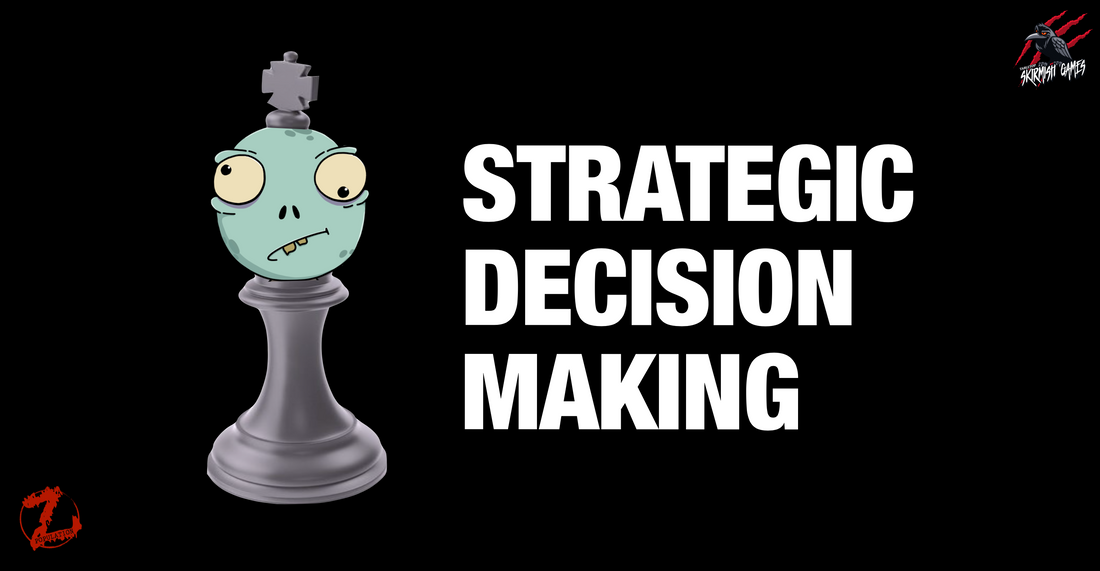Strategic Decision-Making in Tabletop Skirmish Games
In this blog post, we'll discuss the crucial role of strategic decision-making within a game's core mechanics. Good core mechanics give players the opportunity to assess risks, weigh options, and make choices that profoundly impact the outcome of battle. In tabletop skirmish games every move can be the difference between victory and defeat, so let’s break down some of the key elements we can focus on when designing our games.
Strategic Decision-Making: The Backbone of Skirmish Gameplay
Understanding the Dynamics:
When playing tabletop skirmish games players are not just moving pieces on a board; they are commanders, navigating the complexities of the battlefield, and each decision shapes the narrative of the game. These decisions, whether made in movement, combat resolution, or resource management (discussed in a previous blog post here), are the threads weaving the tapestry of victory or defeat.
It’s important to design core mechanics so that players have opportunities for decision making. For example, in Population Z players have a limited number of actions. How they spend these actions will be crucial to the outcome of each Skirmish. If they use too many actions to negotiate the terrain or search for valuable items, they could allow the undead time to close in and surround them. Players need to balance factors like board control and resource management while achieving the objectives and making it out of the scenario alive!
Assessing Risks:
Tabletop skirmish games demand a keen assessment of risks. Players must calculate the potential rewards against the inherent dangers of each action. Whether it's pushing a model forward to claim an objective or pressure an enemy model or holding back for a defensive advantage, understanding and embracing risk is a cornerstone of strategic decision-making. Mechanics that encourage risk assessment add a layer of tension and excitement, making every choice a calculated gamble.
Weighing Options:
The richness of strategic decision-making lies in the number of options available to players. From choosing between aggressive or defensive manoeuvres to selecting the right characters and abilities for a given situation, players must constantly weigh their options. A well-crafted tabletop skirmish game provides players with meaningful choices, ensuring that every decision is a puzzle piece that contributes to the larger strategy.
Post-game consequences provide another layer that can have a big effect on decision making, especially during a campaign played over many skirmishes. As well as immediate outcomes during each battle, providing further consequences that carry over into the future is fun and adds a lot of depth. Consequences help with character development and form stronger bonds between characters and the players. If you care about a character, you might make better decisions for them.
Adaptive Strategies:
No battle plan survives contact with the enemy, and tabletop skirmish games are no exception. Effective strategic decision-making involves the ability to adapt to evolving circumstances on the battlefield. Mechanics that allow players to adjust their strategies in response to the opponent's moves or unexpected events elevate the game's depth, providing a dynamic and engaging experience.
In solo and co-op games this can be limited with a weak AI system but against another human player it’s important to be prepared to adapt, react and perhaps most importantly anticipate their actions. We’ll talk more about AI systems and how randomness can play a big part to help strategic decisions making in future blog posts.
Meaningful Trade-Offs:
Often when playing tabletop skirmish games, you’ll find every advantage comes at a cost. Whether sacrificing movement for a more potent attack or allocating resources for a defensive stance, players must grapple with meaningful trade-offs. Core mechanics that incorporate these trade-offs add layers of complexity, forcing players to prioritise and make decisions that align with their overall strategy.
There will be times where it’s worth sacrificing a fighter in order to gain an advantage in another area of the board or to achieve an objective. Making a sacrifice might entice your opponent to react, and then in turn gives them a meaningful trade off or important decision to make. This back and for is what makes tabletop skirmish games so fun and a good set of core mechanics will encourage this.
Fostering Depth and Replay-ability:
The longevity of a tabletop skirmish game often hinges on its ability to offer depth and replay-ability. Strategic decision-making as an emergent property of good core mechanics helps with the longevity of a game. Games that challenge players to think strategically, providing diverse scenarios and outcomes based on their decisions, ensure that replay-ability is real thing.
Terrain and Scenario Design:
Strategic decision-making extends beyond individual actions; it encompasses the broader context of the battlefield. Games with diverse terrain and scenarios force players to adapt their strategies based on the environment, introducing an extra layer of complexity that enhances both depth and replay-ability.
In Population Z the scenarios are key to strategic decision-making. There will be moral dilemmas built in with decisions to be made that will help or hinder the players in the short and long term. For example, in one Skirmish Scenario players must find a key to be able to use the school bus to escape from Huntsville. They will have the choice to rescue children trapped in the school. If they help they will receive certain bonuses at the end of the Skirmish. If they choose not to help, they lose these bonuses and perhaps a lot more.
Dynamic Campaigns:
For a tabletop skirmish game to stand the test of time, it must offer players a narrative that evolves based on their decisions. Dynamic campaign systems, where the outcome of each battle influences subsequent scenarios and story arcs, provide an immersive experience that keeps players coming back for more.
In Gates of Niflheim the game is played in the game book and the outcome of each scenario influences which scenario will be played next. The game takes on a ‘choose your own adventure’ style and makes each decision even more important for the narrative.
Strategic Decision-Making in Tabletop Skirmish Games
Strategic decision-making is a key feature of tabletop skirmish games, and makes games fun, exciting and challenging. As players navigate the complexities of the battlefield, assessing risks, weighing options, and making meaningful choices, the core mechanics come alive. A well-crafted tabletop skirmish game, with its emphasis on strategic decision-making ensures that each skirmish and scenario is a unique and unpredictable adventure.
I hope you enjoyed this blog post and found it helpful. I’d love to hear your thoughts and opinions on the subject, so join in the conversation in the comments below.
Thanks for reading!
Lee
Look out for my new game, Population Z: Welcome to Huntsville, launching in January 2024.

